
Types of Lights
Indoor Lighting
Until recently, almost all indoor light bulbs were incandescent bulbs, the traditional light bulb. Today there are newer designs that are more efficient and in some cases provide better lighting. The various type of bulbs are discussed below. Before looking at these, you may want to look over the definition of some of the terms found on our Light Bulb Basics page.
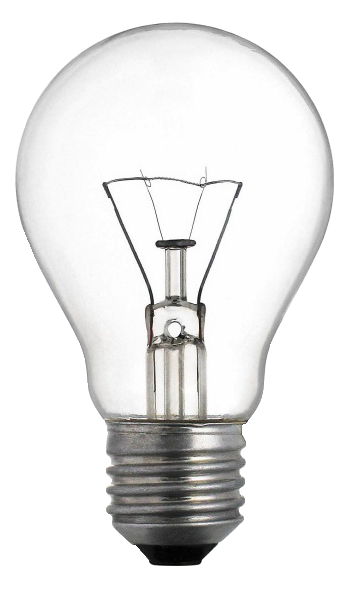 Incandescent Bulbs - The incandescent light bulb has had essentially the same design for over 100 years, ever since it was invented by Thomas Edison. It produces light by passing electricity through a filament, a thin wire made of tungsten, until it glows. Because they release a lot of heat, they are hot to the touch and are very inefficient. This type of bulb has been banned in many countries, including the US, because they are so inefficient.
Incandescent Bulbs - The incandescent light bulb has had essentially the same design for over 100 years, ever since it was invented by Thomas Edison. It produces light by passing electricity through a filament, a thin wire made of tungsten, until it glows. Because they release a lot of heat, they are hot to the touch and are very inefficient. This type of bulb has been banned in many countries, including the US, because they are so inefficient.
| Energy Used* (watts) | 40 | 60 | 75 |
| Brightness* (lumens) | 450 | 800 | 1,100 |
| Efficacy* (lm/watt) | 12.5 | 14.2 | 16.0 |
| CRI* | 100 | ||
*What these terms mean: Wattage, Brightness, Efficacy, CRI.
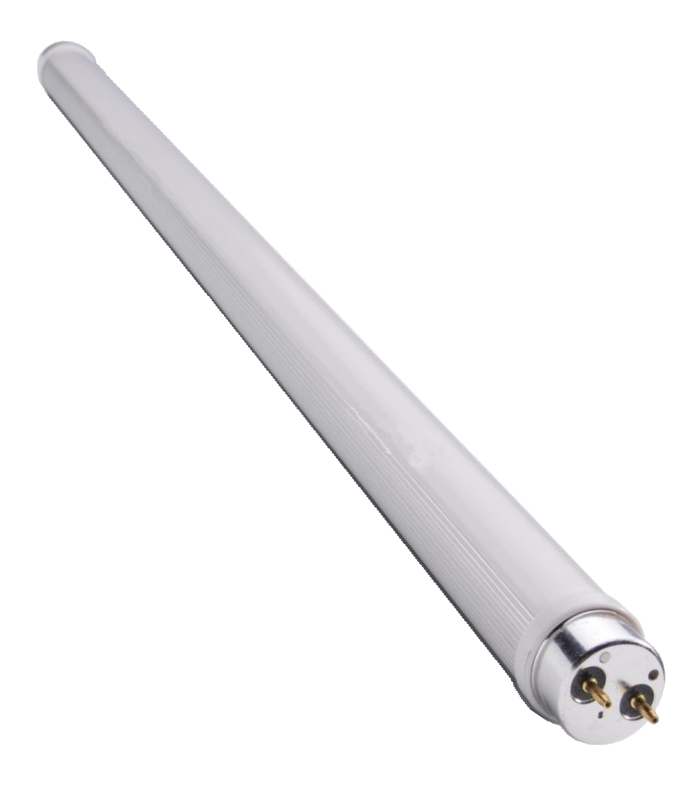 Fluorescent Tubes - Fluorescent tubes produce light by running electricity through a gas, which causes the phosphor coating inside the tube to glow. These bulbs are much more efficient than incandescent bulbs, but are more expensive to install. Because of this, they tend to be used more often in office buildings, warehouses, workshops, and retail stores rather than in homes. Newer style fluorescent tubes are more efficient than the older ones.
Fluorescent Tubes - Fluorescent tubes produce light by running electricity through a gas, which causes the phosphor coating inside the tube to glow. These bulbs are much more efficient than incandescent bulbs, but are more expensive to install. Because of this, they tend to be used more often in office buildings, warehouses, workshops, and retail stores rather than in homes. Newer style fluorescent tubes are more efficient than the older ones.
| Energy Used (watts) | 10-12 | 15-17 | 20-22 |
| Brightness (lumens) | 450 | 800 | 1,100 |
| Efficacy (lm/watt) | 50 - 67 | ||
| CRI | 70 - 90 | ||
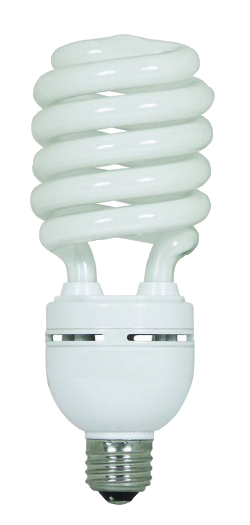 Compact Fluorescent Light (CFL) Bulbs - These bulbs are essentially smaller versions of fluorescent tubes that are spiraled to make them more compact. Like their larger counterparts, they are are far more efficient and run much cooler than standard incandescent bulbs. However, they are not environmentally friendly because they contain mercury.
Compact Fluorescent Light (CFL) Bulbs - These bulbs are essentially smaller versions of fluorescent tubes that are spiraled to make them more compact. Like their larger counterparts, they are are far more efficient and run much cooler than standard incandescent bulbs. However, they are not environmentally friendly because they contain mercury.
| Energy Used (watts) | 9-11 | 13-15 | 18-20 |
| Brightness (lumens) | 450 | 800 | 1,100 |
| Efficacy (lm/watt) | 50 - 70 | ||
| CRI | 50 - 80 | ||
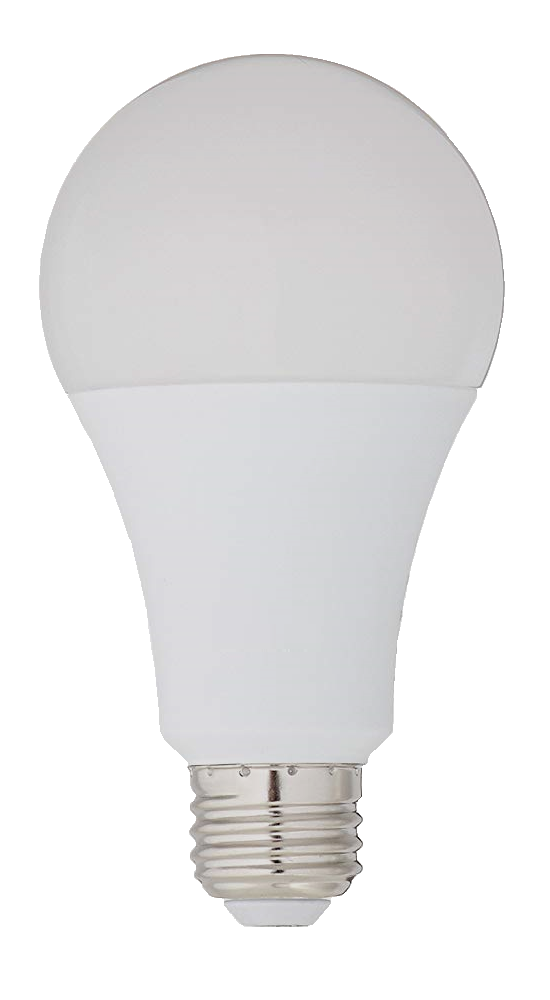 Light Emitting Diode (LED) Bulbs - LEDs use a new type of technology and their invention won the Nobel Prize in Physics in 2014. Although these bulbs are the most efficient bulbs available today, they are not without problems. Some LEDs have a lot more blue light than others. Blue light can have have negative effects on human health and wildlife. To avoid this problem, choose LED bulbs with a color temperature of 2700 K or below.
Light Emitting Diode (LED) Bulbs - LEDs use a new type of technology and their invention won the Nobel Prize in Physics in 2014. Although these bulbs are the most efficient bulbs available today, they are not without problems. Some LEDs have a lot more blue light than others. Blue light can have have negative effects on human health and wildlife. To avoid this problem, choose LED bulbs with a color temperature of 2700 K or below.
| Energy Used (watts) | 5-8 | 8-12 | 10-16 |
| Brightness (lumens) | 450 | 800 | 1,100 |
| Efficacy (lm/watt) | 60 - 100 | ||
| CRI | 80 - 98 | ||
Outdoor Lighting
Outdoor lighting requires different types of bulbs than those used for indoor lighting. They serve in a variety of applications, such as lighting of streets, parking lots, sports fields, and home security. These lamps often need to be brighter and be able to withstand outdoor environments. There are a variety of outdoor lighting types and each have their pros and cons.
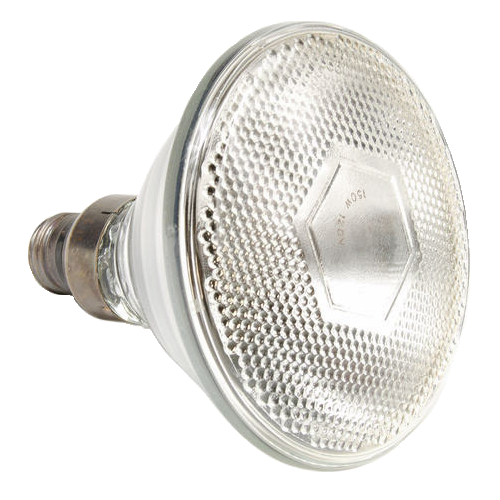 Halogen bulbs - Halogen bulbs are typically used for floodlights around homes, for headlights in cars, or for stadium lighting. These bulbs work in a similar way to incandescent bulbs with electricity passing through a tungsten filament, but unlike incandescent bulbs, the bulb contain halogen gas. When the tungsten burns off the filament, the gas re-deposits it back onto the filament to be reused, making halogen bulbs last much longer than incandescent bulbs. However, these bulbs are much brighter and burn much hotter than traditional incandescent bulbs.
Halogen bulbs - Halogen bulbs are typically used for floodlights around homes, for headlights in cars, or for stadium lighting. These bulbs work in a similar way to incandescent bulbs with electricity passing through a tungsten filament, but unlike incandescent bulbs, the bulb contain halogen gas. When the tungsten burns off the filament, the gas re-deposits it back onto the filament to be reused, making halogen bulbs last much longer than incandescent bulbs. However, these bulbs are much brighter and burn much hotter than traditional incandescent bulbs.
| Energy Used (watts) | 53 | 72 | 75 |
| Brightness (lumens) | 940 | 1350 | 1,500 |
| Efficacy (lm/watt) | 16 - 29 | ||
| CRI | 100 | ||
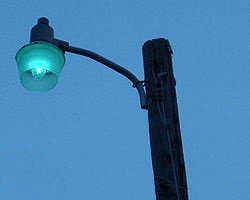 Mercury Vapor - At one time, mercury-vapor lamps were widely used for streets, parking lots, and even outdoor home lighting, but they were banned in the US in 2008. Mercury-vapor lamps produce light by sending an electric arc through vaporized mercury. The arc discharge occurs within a small fused quartz arc tube mounted within a glass bulb. Mercury vapor lamps are more energy efficient than incandescent and most fluorescent lights. They produce white light with a bluish-green tint, which is not flattering to human skin color.
Mercury Vapor - At one time, mercury-vapor lamps were widely used for streets, parking lots, and even outdoor home lighting, but they were banned in the US in 2008. Mercury-vapor lamps produce light by sending an electric arc through vaporized mercury. The arc discharge occurs within a small fused quartz arc tube mounted within a glass bulb. Mercury vapor lamps are more energy efficient than incandescent and most fluorescent lights. They produce white light with a bluish-green tint, which is not flattering to human skin color.
| Energy Used (watts) | 250 | 400 | 1000 |
| Brightness (lumens) | 10,000 | 16,000 | 40,000 |
| Efficacy (lm/watt) | 35 - 60 | ||
| CRI | 20 | ||
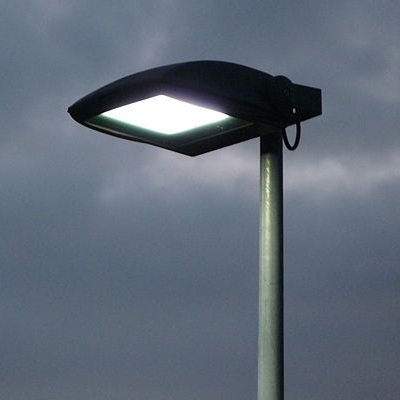 Metal Halide - Metal halide lamps are typically used as streetlights, in parking lots, and for stadium lighting. They produce light by sending an electric arc through a gaseous mixture of vaporized mercury and metal halides. They are very bright and are big contributor to light pollution. They are fairly efficient, producing a very white light with good color rendition.
Metal Halide - Metal halide lamps are typically used as streetlights, in parking lots, and for stadium lighting. They produce light by sending an electric arc through a gaseous mixture of vaporized mercury and metal halides. They are very bright and are big contributor to light pollution. They are fairly efficient, producing a very white light with good color rendition.
| Energy Used (watts) | 250 | 400 | 1000 |
| Brightness (lumens) | 22,000 | 36,000 | 110,000 |
| Efficacy (lm/watt) | 65 - 100 | ||
| CRI | 85 - 94 | ||
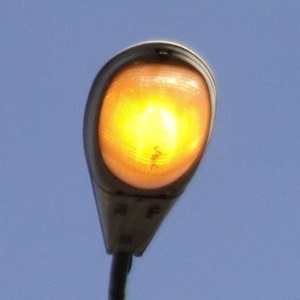 High-Pressure Sodium - High pressure sodium (HPS) lamps are probably the most commonly used street light throughout the world. They work by passing electricity through sodium vapor to produce light. These lamps are often chosen because they are fairly efficient and they require very little maintenance. They are slow to turn on completely and produce a yellow-orange glow, which is their biggest disadvantage. The orange light interferes with astronomers' ability to make measurements of distant stars. They also have poor color rendition.
High-Pressure Sodium - High pressure sodium (HPS) lamps are probably the most commonly used street light throughout the world. They work by passing electricity through sodium vapor to produce light. These lamps are often chosen because they are fairly efficient and they require very little maintenance. They are slow to turn on completely and produce a yellow-orange glow, which is their biggest disadvantage. The orange light interferes with astronomers' ability to make measurements of distant stars. They also have poor color rendition.
| Energy Used (watts) | 150 | 250 | 400 |
| Brightness (lumens) | 16,000 | 24,000 | 50,000 |
| Efficacy (lm/watt) | 40 - 140 | ||
| CRI | 20 - 24 | ||
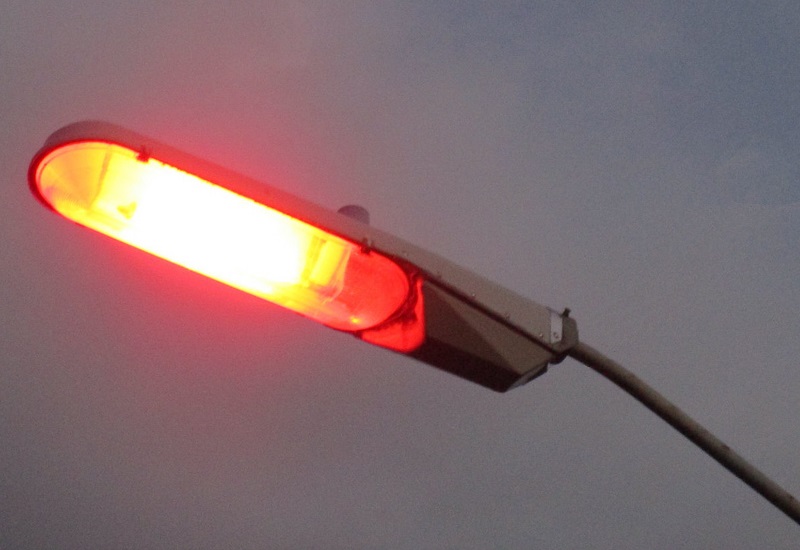 Low-Pressure Sodium - Low pressure sodium (LPS) lamps work similarly to HPS lights. While this lamp is fairly efficient, it produces an almost exclusively yellow light. It has extremely bad color rendition, making objects appear a different color or even gray. The light also interferes with astronomers' measurements.
Low-Pressure Sodium - Low pressure sodium (LPS) lamps work similarly to HPS lights. While this lamp is fairly efficient, it produces an almost exclusively yellow light. It has extremely bad color rendition, making objects appear a different color or even gray. The light also interferes with astronomers' measurements.
| Energy Used (watts) | 18 | 35 | 55 |
| Brightness (lumens) | 1800 | 4550 | 7800 |
| Efficacy (lm/watt) | 100 - 200 | ||
| CRI | -44 | ||
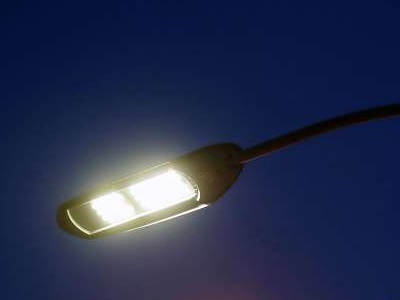 LED Lights - Recent improvements in LED technology have made it possible to produce LED lights for use as street lights and other outdoor lighting applications. The energy savings are significant. However, the biggest drawback is the production of blue light, which can have negative effects on the health of humans and wildlife. To avoid this problem, choose outdoor LED bulbs with a color temperature of 2700 K or below.
LED Lights - Recent improvements in LED technology have made it possible to produce LED lights for use as street lights and other outdoor lighting applications. The energy savings are significant. However, the biggest drawback is the production of blue light, which can have negative effects on the health of humans and wildlife. To avoid this problem, choose outdoor LED bulbs with a color temperature of 2700 K or below.
| Energy Used (watts) | 42 | 146 | 202 |
| Brightness (lumens) | 3,648 | 12,642 | 13,620 |
| Efficacy (lm/watt) | 60 - 100 | ||
| CRI | 80 - 98 | ||
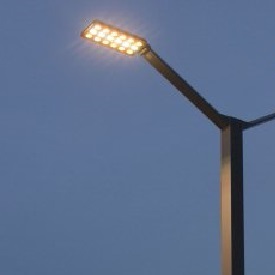 Phosphor-Converted Amber (PCA) LED Lights - PCALEDs have only been on the market for a few years. PCALEDs use a phosphor to convert blue light to green, yellow, amber, and red light. While they appear amber in
color, they have much better color rendition than high-pressure sodium. Because they produce very little blue light, they are a good choice to help preserve the dark night sky. They have a much lower impact on animals compared to white light.
Phosphor-Converted Amber (PCA) LED Lights - PCALEDs have only been on the market for a few years. PCALEDs use a phosphor to convert blue light to green, yellow, amber, and red light. While they appear amber in
color, they have much better color rendition than high-pressure sodium. Because they produce very little blue light, they are a good choice to help preserve the dark night sky. They have a much lower impact on animals compared to white light.
| Energy Used (watts) | 100 | 200 | 300 |
| Brightness (lumens) | 6,100 | 12,200 | 18,300 |
| Efficacy (lm/watt) | 30 - 40 | ||
| CRI | 59 | ||
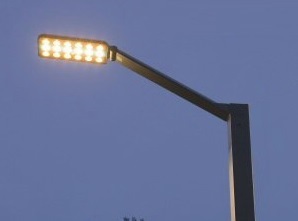 Narrow-Band Amber (NBA) LED Lights - Narrow-band amber (NBA) LED street lights are a recently developed technology. They emit primarily yellow-amber colored light directly, without using a phosphor like that used in PCALED lights. They have a lower color rendition than PCALEDs, but they produce less interference with astronomy. They are also the preferred lighting solution for endangered species, such as turtles, that are affected by light at night. However, because they can experience significant thermal instability, causing light output to diminish over time, they have not achieved significant market penetration.
Narrow-Band Amber (NBA) LED Lights - Narrow-band amber (NBA) LED street lights are a recently developed technology. They emit primarily yellow-amber colored light directly, without using a phosphor like that used in PCALED lights. They have a lower color rendition than PCALEDs, but they produce less interference with astronomy. They are also the preferred lighting solution for endangered species, such as turtles, that are affected by light at night. However, because they can experience significant thermal instability, causing light output to diminish over time, they have not achieved significant market penetration.
| Energy Used (watts) | 100 | 200 | 300 |
| Brightness (lumens) | 3,200 | 6,400 | 9,600 |

